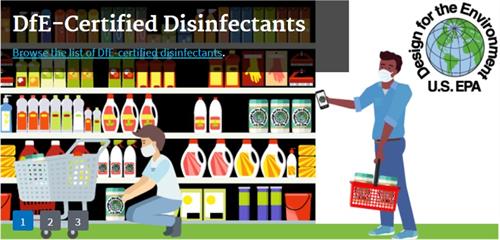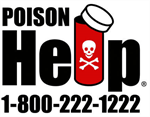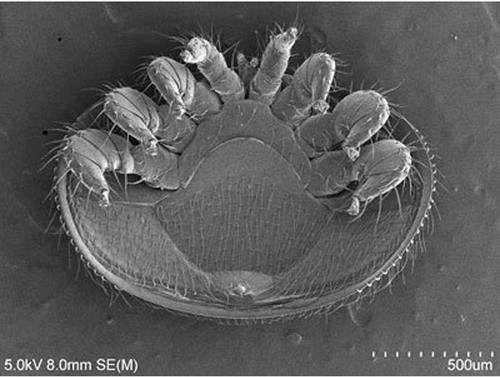
Dawn H. Gouge1, Shaku Nair1, Lynn Rose2 Mansel Nelson3, Janet A. Hurley4,
Tim Stock5, Shujuan (Lucy) Li1, Virginia McGregor6.
1University of Arizona, Department of Entomology, 2New Hampshire Department of Environmental Services, 3Northern Arizona University, Institute for Tribal Environmental Professionals, 4Texas A&M University System, Texas AgriLife Extension Service, 5Oregon State University, Department of Horticulture, 6Scottsdale Unified School District.
New cleaning and disinfection guidance was released April 5, 2021 by the Centers for Disease Control and Prevention (CDC https://www.cdc.gov/coronavirus/2019-ncov/community/disinfecting-building-facility.html). The CDC state “The principal mode by which people are infected with SARS-CoV-2 (the virus that causes COVID-19) is through exposure to respiratory droplets carrying infectious virus. It is possible for people to be infected through contact with contaminated surfaces or objects (fomites), but the risk is generally considered to be low.”
Cleaning with products containing soap or detergent reduces germs on surfaces by removing contaminants and may also weaken or damage some of the virus particles, which decreases risk of infection from surfaces.
When no people with confirmed or suspected COVID-19 are known to have been in a space, cleaning once a day is usually enough to sufficiently remove virus that may be on surfaces and help maintain a healthy facility.
Disinfecting using List N products https://www.epa.gov/pesticide-registration/list-n-disinfectants-coronavirus-covid-19 destroys any remaining germs on surfaces, which further reduces any risk of spreading infection.
You may want to either clean more frequently or choose to disinfect (in addition to cleaning) in shared spaces if:
If there has been a sick person or someone who tested positive for COVID-19 in your facility within the last 24 hours, you should clean AND disinfect the space.
As many school students resume in-person classes, some school districts are requesting students bring disinfectant wipes into school from home. Disposable wipes may seem a simple and convenient solution to in-class cleaning and disinfection needs, but there are several factors school communities must consider.
Here are ten things you need to consider before requesting disinfectant wipes from home:


Figure 2. Many types of wipes are available for purchase.
Pesticide label references to “cleaning”, “disinfecting” and “sanitizing” properties mean different things.
Cleaning removes bacteria, virus, and other pathogens (germs), dirt, and impurities from surfaces or objects. Cleaning works by using soap (or detergent), water and scrubbing action to physically remove germs from surfaces. This removal process lowers pathogen numbers and the risk of infection.
Disinfectants contain chemicals that kill or deactivate specific pathogens indicated on labels. They are used to disinfect surfaces or objects. This process is done AFTER you have cleaned a surface and disinfectants further lowers the risk of infection. Only wipes listed in EPA List N are approved for use against SARS-CoV-2, and only if they are used according to label directions.
Sanitizing products use chemicals to lower the number of pathogens on surfaces or objects to a safe level, as judged by public health standards or requirements.
This process is done AFTER you have cleaned a surface.
Some products are EPA approved as both a sanitizer and a disinfectant, however contact times differ and are pathogen specific. Currently, there are no sanitizer-only products with approved virus claims. For this reason, sanitizers do not qualify for inclusion on EPA’s List N: Disinfectants for Use Against SARS-CoV-2 (COVID-19).
Products for “surface” sanitizing (EPA antimicrobial pesticide) and “hand” sanitizing (FDA over-the-counter drug) may look very similar (Figure 3). Some have different ingredients, while some have similar ingredients. However, these products are regulated by two different agencies, and are NOT interchangeable.

Figure 3. Both products are labeled as Alcohol Wipes, but the product on the left is an EPA regulated disinfectant for surfaces, and the product on the right is an FDA regulated hand wipe product.
Purchasing disinfectant wipes from internet sites can further increase risks to students and school staff. Parents and guardians may inadvertently purchase hospital grade wipes made for medical facility use. These may have additional risks of exposure if the correct Personal Protective Equipment (PPE) is not used. Depending upon the product, chemically resistant gloves may be stipulated on the label.
Even more concerning is the online sale of illegal products which look like EPA registered products but may contain entirely different chemicals than those indicated.
Finally, many families are suffering considerable financial difficulties and requiring students to bring supplies will drive parents and guardians to seek the cheapest options or could even result in missed in-person school days if families cannot afford to purchase supplies.
Use of disinfectant wipes may incur regulatory compliance challenges and lost time learning time in class. Some wipes may require the use of chemically resistant gloves and hands should always be washed with soap and water after using disinfectant wipes, even if gloves are worn. This could take considerable instruction time from teachers.
For teachers and students transitioning classrooms 6-8 times a day, 5 days a week, using disinfectants before each transition can incur unusual chemical exposure. Please note, store-bought disinfectant products used in this way far exceeds the frequency and duration of normal consumer use. Therefore, the use of such products would necessitate inclusion in an employer's hazard communication program (https://www.osha.gov/laws-regs/regulations/standardnumber/1910/1910.1200). This would involve training on hazards and precautions, and staff access to product labels in a familiar language and safety data sheets at each location.
Disposing of wipes can pose challenges. Most wipes come with warnings not to flush them down a toilet, but even those labeled as “flushable” or “septic-safe” can still cause plumbing blockages, clogged sewers, and septic systems. The result can be hefty plumbing bills.
Most wipes are not compostable. Most are made from cellulosic fibers (cotton, wood pulp, viscose, lyocell) and thermoplastic fibers (polyethylene terephthalate, and polypropylene). You can find compostable wipes made from wood-based fibers and bamboo, but make sure you find compostable claims if this is what you want, simply seeing “earth friendly” or “biodegradable” on packaging is not the same.
Many ingredients in wipes can pose health and safety risks. Wipes come with different active ingredients and additives. Please be aware, commonly found active ingredients can irritate eyes, skin and trigger asthma symptoms including chlorine bleach (sodium hypochlorite), and quaternary ammonium compounds (benzalkonium chlorides). Inert ingredients can also be problematic. Adequate ventilation while using products is vitally important.
All school districts SHOULD have a policy restricting cleaning supplies including disinfectants to those approved by the School Board. This is for the safety of both the students they educate, who spend about one third of their time in school, and the employees and volunteer staff, who spend even more time in school buildings. Having a clear inventory of chemicals on school property reduces risk and litigation losses that follow injury incidents.
Finally, recent events have documented increases in negative health impacts caused by cleaning and disinfection in both homes and school settings (CDC, 2020 https://www.cdc.gov/mmwr/volumes/69/wr/pdfs/mm6916e1-H.pdf).
Expert consideration of the relative risks posed by SARS-CoV-2 and products being used to disinfect is clearly in order.
To find options with lower risk look for the EPA Design for the Environment logo on products (Figure 4). For more information on safer options see https://www.epa.gov/pesticide-labels/dfe-certified-disinfectants.

Figure 4. Learn more about Design for the Environment labeled disinfectants.
Safer active ingredients for disinfectants currently available include hydrogen peroxide, citric acid, lactic acid, and ethanol.
Some surfaces require the use of a disinfectant that is “food contact” approved. Due to the provision of meals and need for physical distancing, classrooms are increasingly used as food consumption areas. Many wipes should not be used on food preparation surfaces. Some approved for food contact surfaces require rinsing with water, and some like CleanCide® Germicidal Detergent Wipes (citric acid) do not.
Mixing products can result in serious injury or death. NEVER mix a disinfectant with another disinfectant, home-made cleaning solutions, store-bought cleaning products or hand sanitizer. For example, mixing chlorine bleach and ammonia cleaners can lead to the production of potentially lethal chlorine gas (Table 1).
Table 1. Never mix cleaning, disinfectant, or hand sanitizers.
|
Ingredient 1 |
Ingredient 2 |
Results |
Short, low-level exposure |
|
Bleach (sodium hypochlorite) |
Ammonia (quats) |
Chloramine gas |
Coughing, nausea, shortness of breath, watery eyes, chest pain, throat, nose and eye irritation, wheezing. |
|
Bleach (sodium hypochlorite) |
Vinegar or other acid |
Chlorine gas |
Ear, nose and throat irritation, coughing, difficulty breathing, burning, watery eyes, runny nose. |
|
*Bleach (sodium hypochlorite) |
Isopropyl (rubbing) alcohol |
Chloroform and hydrochloric (muriatic) acid liquid |
Corrosive burns of eyes, nose, and skin, shortness of breath. |
|
Bleach (sodium hypochlorite) |
Hydrogen peroxide |
Oxygen, salt, and water |
Even with a bleach concentration of 5% mixing these solutions generates fizzing, frothing and a useless solution. |
|
Bleach (sodium hypochlorite) |
Peracetic acid |
Chlorine gas |
Ear, nose and throat irritation, coughing, difficulty breathing, burning, watery eyes, runny nose. |
|
Bleach (sodium hypochlorite) |
Acetone (propanone) |
Chloroform, sodium hydroxide & acetic acid |
Corrosive burns of eyes, nose, and skin, coughing, shortness of breath. |
|
Hydrogen peroxide |
Vinegar or another acid |
Peracetic acid liquid (also used as a disinfectant but may require higher PPE requirements) |
Cough, shortness of breath, burns to the eyes, nose, and throat. |
*Many hand sanitizers are alcohol-based. If students are using hand sanitizers as part of hand hygiene measures, they must not handle incompatible surface disinfectant wipes at the same time.
Never store disinfectants under classroom sinks, on overhead shelving,
or in student accessible areas.
Resources
CDC April 5, 2021 brief on surface cleaning and disinfection needs: https://www.cdc.gov/coronavirus/2019-ncov/more/science-and-research/surface-transmission.html.
EPA April 2021 Factsheet on cleaning and disinfecting https://www.epa.gov/sites/production/files/2021-04/documents/cleaning-disinfecting-one-pager.pdf.
The Centers for Disease Control and Prevention (CDC) recommends the use of EPA Design for the Environment products to be used for cleaning and disinfection in schools: https://www.cdc.gov/asthma/triggers.html?CDC_AA_refVal=https%3A%2F%2Fwww.cdc.gov%2Fasthma%2Freduce_triggers.html#cleaning_disinfection.
The Toxics Use Reduction Institute (TURI) is part of the University of Massachusetts Lowell and conducts performance tests of safer cleaning chemicals. TURI offers guidance on how to reduce your risk to the coronavirus while also avoiding unnecessary exposure to toxic chemicals: https://www.turi.org/Our_Work/Cleaning_Laboratory/COVID-19_Safely_Clean_Disinfect. School specific information can be found here: https://www.turi.org/Our_Work/Cleaning_Laboratory/COVID-19_Safely_Clean_Disinfect/Safer_Cleaning_and_Disinfection_for_Schools.
The CDC provides guidance on how to improve ventilation here: https://www.cdc.gov/coronavirus/2019-ncov/community/ventilation.html.
CDC National Institute for Occupational Safety and Health (NIOSH) provide information for employers and workers who use cleaning products and disinfectants: https://www.cdc.gov/niosh/topics/disinfectant/default.html.
The National Pesticide Information Center (NPIC) provides guidance on understanding and selecting antimicrobial pesticides http://npic.orst.edu/ingred/ptype/amicrob/index.html. NPIC also has infographics for download at http://npic.orst.edu/outreach/covid-infographic.png and http://npic.orst.edu/outreach/amicroinfographic.png.If a medical emergency occurs call 911.
If an exposure occurs call the poison help line at 1-800-222-1222.

The National Pesticide Information Center can offer guidance 1-800-858-7378 npic@ace.orst.edu. Open 8:00AM to 12:00PM Pacific Time, Monday-Friday.

Our thanks to the article reviewer. This article has been reviewed for technical accuracy by: Gwen Borlaug, MPH Infection Prevention and Antimicrobial Stewardship Specialist, Arizona Department of Health Services.

Special recognition goes to Virginia McGregor, retired teacher, and substitute with over 50 years of teaching experience in Scottsdale Unified School District. Virginia works tirelessly as a student health advocate and pushes constantly for environmental improvements in learning environments for the benefit of students, teachers, and staff.
What the Heck is This!?!

If you know what this is email the answer to Dawn at dhgouge@email.arizona.edu. You will not win anything if you are correct, but you will be listed as a “Proficient Pest Detective” in the next newsletter issue.
Earth Day is an annual event aimed at improving environmental awareness and demonstrating support for environmental protection. First held on April 22, 1970, it now includes a wide range of events coordinated globally by EARTHDAY.ORG (formerly Earth Day Network) and includes 1 billion people in more than 193 countries. The theme of Earth Day 2021 is Restore Our Earth™ https://www.earthday.org/earth-day-2021/. Make every day Earth Day by using IPM!
Save the Date! The 4th Arizona School IPM Conference will be offered ONLINE April 19-May 31, 2021. The conference is a great opportunity for continuing education, professional development, and awareness building; consisting of engaging presentations for all persons involved with schools, childcare and similar facilities, and other sensitive environments; and anyone with an interest in ensuring safe, healthy learning and working environments. Listen to talks by experts on various aspects of school IPM, share your experiences and questions, and find solutions to pest issues your school is facing. Give feedback on topics you would like to see in future events. The conference will offer 6 or 12 Arizona PMD CEUs, 6 Arizona AG CEUs and 12 NEHA Registered Sanitarian Credits. Registration and more information https://acis.cals.arizona.edu/community-ipm/events/arizona-school-ipm-conference.
Who can attend? Anyone with an interest in safe and effective pest management in schools, childcare and similar facilities. Typically, our audience includes school and other administrative staff, maintenance and operations staff, grounds and landscape managers, teachers, principals, nurses, parents, and pest control technicians, food service staff, facility managers, superintendents, medical professionals, students, and many others.
May 21, 2021, Live online 3 Tracks available until June 20, 2021.
The Desert Horticulture Conference is the premier annual conference for all members of the southwest green industry: landscape architects, designers, growers, retailers, contractors, maintenance personnel, suppliers, and educators. Presenting timely and research-based information relevant for designing, building, maintaining, and producing plants for urban landscapes in the arid Southwest.
Registration will open soon: https://cals.arizona.edu/deserthort/.
IPM for Spotted Lanternfly. April 13, 2021, 11:00 AM 1 12:30 PM MST.
This topic is a continuation of the EPA’s ‘IPM for Tree Pests’ webinar series and will review one of the newest invasive challenges to face trees in the U.S. ─ the spotted lanternfly. Join us to learn about the environmental and the economic devastation currently taking place throughout the mid-Atlantic states. This webinar will present the latest in prevention and control strategies used by arborists, including pesticides (biopesticides and conventional pesticides), cultural controls, and biological controls. This 90-minute webinar will offer 1.5 Arizona AG CEUs. Continuing education credits will also be available through some tree/arborist and pest management associations. Full attendance and taking a quiz will be required for those needing CEUs. To register: https://register.gotowebinar.com/register/5722564806418995983.
IPM After the Storm – Vector Considerations Part 2. May 4, 2021, 11:00 AM - 12:30 PM MST.
This is the second part of a two-part webinar series, that will delve into the special considerations vectors warrant following environmental disasters/emergencies such as hurricanes, tornadoes, floods and even pandemics in urban areas. It’s easy to lose sight of the importance of vector control immediately following a natural disaster or during a pandemic. Understanding how to react and what to expect may help people control disaster-related increases in pests and vector-borne diseases. Drawing on past examples, this webinar will discuss pest-related consequences of disasters/emergencies and the short- and long-term actions that can be taken to minimize disease transmission through integrated vector control programs. This 90-minute webinar will offer 1.0 Arizona AG and 1.0 PMD CEU. Continuing education credits will also be available through some tree/arborist and pest management associations. Full attendance and taking a quiz will be required for those needing CEUs. To register: https://register.gotowebinar.com/register/5947185136387110924.
Open now for on-demand CEs. To register contact Dr. Lucy Li lucyli@email.arizona.edu
The Vector Preparedness Virtual Workshop is a great opportunity for anyone with an interest in learning information on mosquito ID, surveillance, management, and insecticide resistance in public health pests.
This workshop will present:
Arizona certified structural pesticide applicators can earn 4 CEUs from the AZ Department of Agriculture’s Pest Management Division (PMD) after completing the entire workshop. This course will be effective through August 30, 2021.
Check out upcoming Integrated Pest Management Webinars at https://www.epa.gov/managing-pests-schools/upcoming-integrated-pest-management-webinars
For more information about the EPA Schools program: http://www.epa.gov/schools/.
To view all our previous newsletters, visit: https://acis.cals.arizona.edu/community-ipm/home-and-school-ipm-newsletters.
Acknowledgements
This material is in part funded by the National Institute of Food and Agriculture, U.S. Department of Agriculture, under award number 2017-70006-27145 that provides Extension IPM funding to the University of Arizona. Information regarding this document is within the guidelines of the Border 2020 Program funded by the U.S. Environmental Agency (EPA) and administered by NADB. Additional support is provided by the U.A. – Arizona Pest Management Center.